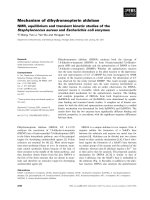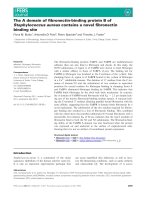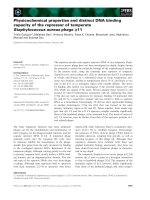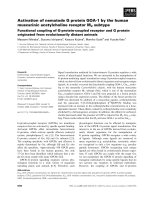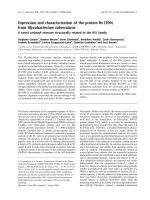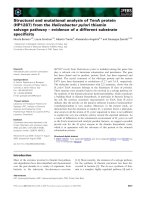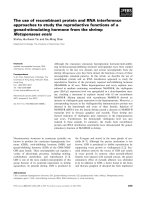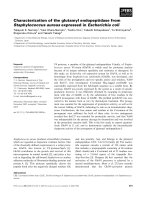DEAD box protein csha from staphylococcus aureus and RNA dependent RNA polymerases from viruses
Bạn đang xem bản rút gọn của tài liệu. Xem và tải ngay bản đầy đủ của tài liệu tại đây (2.69 MB, 126 trang )
Dissertation for Degree of Doctor
Supervisor: Prof. Dong-Eun Kim
Enzymatic Studies on Nucleic Acid
Binding Proteins: DEAD-box Protein
CshA from Staphylococcus aureus and
RNA-dependent RNA Polymerases
from Viruses
Submitted by
NGUYEN THI DIEU HANH
February, 2015
Department of Bioscience and Biotechnology
Graduate School of Konkuk University
Enzymatic Studies on Nucleic Acid
Binding Proteins: DEAD-box Protein
CshA from Staphylococcus aureus and
RNA-dependent RNA Polymerases
from Viruses
A Dissertation submitted to the Department of Bioscience and
Biotechnology and the Graduate School of Konkuk University
in partial fulfillment of the requirements for the degree of
Doctor of Philosophy
Submitted by
NGUYEN THI DIEU HANH
October, 2014
This certifies that the Dissertation of
NGUYEN THI DIEU HANH is approved.
Approved by Examination Committee:
Chairman
Member
Member
Member
Member
November, 2014
Graduate School of Konkuk University
TABLE OF CONTENTS
List of Tables .....................................................................................................iv
List of Figures .................................................................................................. iii
List of Scheme ..................................................................................................vii
Abstract .......................................................................................................... viii
Chapter 1. Characterization of DEAD-box protein CshA from Staphylococcus
aureus on RNA substrates ....................................................................................... 1
1.1. Introduction ................................................................................................. 1
1.1.1. Staphylococcus aureus .......................................................................... 1
1.1.2. DEAD-box protein ................................................................................ 3
1.1.3. The role of DEAD-box protein CshA in S. aureus.................................. 4
1.2. Materials and Methods ................................................................................. 9
1.2.1. Preparation of recombinant S. aureus CshA ........................................... 9
1.2.2. Preparation of RNA oligonucleotides..................................................... 9
1.2.3. RNA-dependent ATP hydrolysis .......................................................... 11
1.2.4. Duplex RNA unwinding assay ............................................................ 11
1.2.5. Ribonuclease assay ............................................................................. 12
1.2.6. RNA strand annealing assay ................................................................ 13
1.2.7. RNA strand exchange assay................................................................. 13
1.3. Results. ...................................................................................................... 15
1.3.1. Duplex RNA stimulates ATP hydrolysis by S. aureus CshA ................. 15
1.3.2. S. aureus CshA is unable to catalyze RNA unwinding .......................... 17
1.3.3. S. aureus CshA possesses ribonuclease activity ................................... 19
i
1.3.4. S. aureus CshA is an endoribonuclease that cleaves ssRNA at preferred
sequences ..................................................................................................... 23
1.3.5. S. aureus CshA possesses RNA strand annealing activity ..................... 30
1.4. Discussion ................................................................................................. 36
1.5. Conclusion ................................................................................................. 41
Chapter 2. Functions of DEAD-box Protein CshA from Staphylococcus aureus on
DNA substrates .................................................................................................... 42
2.1. Introduction ............................................................................................... 42
2.2. Methods ..................................................................................................... 44
2.2.1. Nucleic acid substrates ........................................................................ 44
2.2.2. DNA filter-binding assay..................................................................... 47
2.2.3. ATP hydrolysis .................................................................................... 48
2.2.4. Duplex DNA unwinding assay ............................................................ 48
2.2.5. DNA strand exchange assay ................................................................ 49
2.2.6. DNA strand annealing assay ................................................................ 50
2.2.7. Inhibition assay of DNA strand annealing ............................................ 51
2.3. Results ....................................................................................................... 53
2.3.1. S. aureus CshA binds to duplex DNA with overhangs .......................... 53
2.3.2. DNA strand exchange is promoted by S. aureus CshA ......................... 57
2.3.3. S. aureus CshA catalyzes strand annealing of complementary ssDNA
into dsDNA .................................................................................................. 67
2.3.4. S. aureus CshA anneals partial duplex DNAs into nicked or gapped
dsDNA ......................................................................................................... 74
2.3.5. CshA-mediated DNA strand annealing is inhibited by dsDNA and high
NaCl concentration ....................................................................................... 78
ii
2.4. Discussion ................................................................................................. 82
2.5. Conclusion ................................................................................................. 87
Chapter 3. Efficient colorimetric assay for RNA synthesis by viral RNA-dependent
RNA polymerases using thermostable pyrophosphatase ........................................ 88
3.1. Introduction ............................................................................................... 88
3.2. Materials and Methods ............................................................................... 91
3.2.1. Preparation of recombinant proteins .................................................... 91
3.2.2. Pyrophosphate hydrolysis assay .......................................................... 91
3.2.3. Colorimetric assay of RdRp activity .................................................... 92
3.2.4. Radioactive assay of RdRp activity ..................................................... 92
3.2.5. Inhibition assay of DMUT (3'-deoxy 5-methyl-uridine-5'triphosphate) on
RdRp activity ............................................................................................... 93
3.3. Results and Discussion ............................................................................... 93
3.3.1. Conversion pyrophosphate to inorganicphosphate by thermostable
pyrophoaphatase ........................................................................................... 93
3.3.2. Comparison of the colorimetric assays to measure RdRp activity......... 96
3.3.3. Use of the colorimetric assay to detect RdRp activity from the crude
cellular extract .............................................................................................. 97
3.3.4. Application of the colorimetric assay for RNA synthesis by RdRp to
screen inhibitor ........................................................................................... 101
3.4. Conclusions ............................................................................................. 103
References ...................................................................................................... 104
iii
List of Tables
Table 1.1. Sequences of single-stranded RNAs used in this study ......................... 10
Table 1.2. Structures of double-stranded RNA substrates used in this study .......... 10
Table 2.1. Oligonucleotides used in this study ...................................................... 45
Table 2.2. Structures of DNA substrates ............................................................... 46
iv
List of Figure
Figure 1.1. Scheme of different sites of staphylococcal infections and biofilm of
Staphylococcus aureus............................................................................................ 2
Figure 1.2. Conversed motifs of DEAD-box proteins ............................................. 3
Figure 1.3. The current model of Bacillus subtilis and Staphylococcus aureus ........ 5
Figure 1.4. Model of CshA in the degradation of the agr mRNA in the wild type and
CshA mutant type ................................................................................................... 7
Figure 1.5. RNA-dependent ATP hydrolysis by S. aureus CshA ........................... 16
Figure 1.6. RNA duplex unwinding by Staphylococcus aureus CshA ................... 18
Figure 1.7. CshA degrades the single-stranded RNA region of duplex RNA
substrates ............................................................................................................. 21
Figure 1.8. CshA did not possess 5’-exoribonuclease activity ............................... 24
Figure 1.9. CshA is an endoribonuclease .............................................................. 26
Figure 1.10. Mapping of RNA cleavage sites on two different single-stranded RNA
substrates (R0 and BR0) in RNA degradation by CshA ......................................... 29
Figure 1.11. RNA strand annealing activity of CshA ............................................ 32
Figure 1.12. S. aureus CshA does not catalyze RNA strand exchange ................... 35
Figure 1.13. Catalytic activities of S. aureus CshA on RNA substrates ................. 40
Figure 2.1. DNA binding and ATP hydrolysis by the recombinant CshA from S.
aureus .................................................................................................................. 55
Figure 2.2. CshA shows DNA strand exchange activity rather than dsDNA
unwinding ............................................................................................................ 58
Figure 2.3. DNA strand exchange activity of CshA on various dsDNA substrates 63
v
Figure 2.4. Assay for the DNA strand exchange activity of CshA with 3′-tail
dsDNA substrate to form a forked dsDNA product ................................................ 65
Figure 2.5. ssDNA strand annealing by CshA ....................................................... 69
Figure 2.6. ssDNA strand annealing activity of CshA to form diverse dsDNA
products ............................................................................................................... 72
Figure 2.7. Formation of duplex DNAs with gap and nick is promoted by CshA .. 76
Figure 2.8. Inhibition of CshA-catalyzed DNA strand annealing with dsDNA
competitor and high concentration of salt .............................................................. 80
Figure 2.9. Plausible roles of DNA annealing and DNA strand exchange activities
by CshA in dsDNA break repair ............................................................................ 86
Figure 3.1. Colorimetric detection of RNA polymerase activity using thermostable
pyrophosphatase ................................................................................................... 95
Figure 3.2. Comparison of RdRp activity assay methods between colorimetric assay
and radioactive assay ............................................................................................ 97
Figure 3.3 The colorimetric assay of FMDV 3Dpol RdRp from the crude cellular
extract .................................................................................................................. 99
Figure 3.4. Inhibition of 3’-deoxy 5-methyl-uridine-5’triphosphate (DMUT) on the
activity of FMDV 3Dpol..................................................................................... 102
vi
List of Scheme
Scheme 3.1. Reaction scheme for colorimetric assay of RNA polymerase ............ 90
vii
Abstract
Enzymatic Studies on Nucleic Acid Binding Proteins:
DEAD-box Protein CshA from Staphylococcus aureus
and RNA-dependent RNA Polymerases from Viruses
Nguyen, Thi Dieu Hanh
Department of Bioscience and Biotechnology
Graduate School of Konkuk University
Nucleic acids and proteins are two of the most important biomolecules in
every living organism. Interactions between nucleic acids (RNA and DNA) and
proteins are required to play important roles in central biological processes, ranging
from replication of genome, transcription, translation and recombination, in which
the nucleic acid binding proteins utilize nucleic acids as substrates in the enzymatic
reactions. Based on their functions, nucleic acid binding proteins can be divided
into several groups, including polymerases, transcription factors, nucleases and
other enzymes and structural proteins. In my study, two classes of nucleic acid
binding proteins from bacteria and virus were chosen for enzymatic studies; DEADbox protein (CshA from Staphylococcus aureus) and viral RNA-dependent RNA
polymerases.
viii
In the first chapter, I investigated DEAD-box protein CshA from
Staphylococcus aureus for its unusual enzymatic activities on RNA. DEAD-box
proteins are an important class of proteins that are widely distributed in both
prokaryotes and eukaryotes. These proteins are characterized as putative RNA
helicases and are involved in nearly all RNA metabolic processes, including
transcription, splicing, RNA transport, ribosome biogenesis, translation, and RNA
decay. Recently, it has been reported that some DEAD-box proteins are known to be
components of the RNA degradosome, albeit it does not cleave RNA directly. To
date, detailed role of the DEAD-box proteins in the RNA degradation is poorly
understood. In this study, I demonstrated that the DEAD-box protein CshA from the
vancomycin-resistant Staphylococcus aureus strain Mu50 possesses RNA
endoribonuclease activity and complementary RNA strand annealing activity.
Despite having RNA-dependent ATPase activity, CshA did not exhibit RNA
helicase activity in vitro. Instead, CshA catalyzed the degradation of single-stranded
RNAs at phosphodiester bonds between adenine or uracil and any bases (A-N and
U-N), and cytosine and other bases except guanine (C-A/U/C). In addition, I
observed that CshA possesses RNA strand annealing activity, which converts
complementary single-stranded RNA substrates into double-stranded RNA duplexes.
Thus, I suggest that the endoribonuclease and RNA strand annealing activities of the
DEAD-box protein CshA may contribute to RNA remodeling in the bacterial RNA
degradosome. To my knowledge, this study is the first to report that a DEAD-box
protein from a pathogenic bacterium is implicated in multiple ATP-independent
activities on RNA, such as annealing and degradation.
ix
In the second chapter, I examined enzymatic activities of CshA on DNA
substrates. I observed that CshA has two ATP-independent activities; annealing of
complementary single-stranded DNA (ssDNA) and strand exchange on short
double-stranded DNA (dsDNA). These DNA strand annealing and exchange
activities are independent of Mg2+ or ATP binding and hydrolysis. CshA binds to
dsDNA containing diverse end structures with various affinities: forked dsDNA >
tailed dsDNA > blunt-end dsDNA. The rate and efficiency of CshA-catalyzed
ssDNA annealing and DNA strand exchange is negatively correlated with the
binding affinities of CshA to the dsDNA product. ssDNA annealing activity with
tailed dsDNA substrates as well as versatile DNA strand exchange activity of CshA
suggests a possible role in dsDNA break repair processes.
In the last chapter, I developed a novel method for assaying the RNA synthesis
activities of RNA-dependent RNA polymerase (RdRp). RdRp is another class of
nucleic acid binding protein, which is essential for the replication of the RNA
genome-containing positive-strand RNA viruses. To screen potential drug
candidates against RNA viruses, a simple method to detect activity of RdRp is
necessary. I developed a simple colorimetric assay to quantify the RNA synthesis
activity of RdRp by measuring the pyrophosphates released during nascent RNA
synthesis. RNA polymerase reaction was quenched by heating at 70 °C for 5 min,
during which thermostable inorganic pyrophosphatase converted the accumulated
pyrophosphates into inorganic phosphates. Subsequently, the amount of inorganic
phosphate was measured using a color-developing reagent. Using RdRps from
hepatitis C virus and the foot-and-mouth disease virus, I demonstrated that this
x
colorimetric assay facilitates the measurement of RNA polymerase activity.
Taken together, I have studied and investigated detailed biochemical
enzymatic properties of two nucleic acid binding proteins from bacteria and viruses.
My studies on enzymatic activities of the DEAD-box protein CshA for DNA and
RNA will contribute for development of antibiotics against S. aureus, because the
DEAD-box protein CshA is indispensable for bacterial pathogenesis. In addition, I
have developed a simple and efficient assay method for detection of viral RdRp
activity. This assay method will facilitate high-throughput screening of antiviral
drug candidates against several pathogenic RNA viruses such hepatitis C virus
(HCV) and foot-and-mouth disease virus (FMDV).
Key
words:
endoribonuclease,
DEAD-box
RNA-dependent
protein,
RNA
xi
CshA,
polymerase,
Staphylococcus aureus,
colorimetric
assay.
Chapter 1. Characterization of DEAD-box protein
CshA from Staphylococcus aureus on RNA substrates
1.1. Introduction
1.1.1. Staphylococcus aureus
Staphylococcus aureus is known as at Gram-positive bacterial pathogens that
causes wide spectrum of diseases from innocuous skin to severe life-threatening
infections. S. aureus is a prominent infectious bacterium that causes nosocomial and
post-surgical wound infections. S. aureus can cause minor infections as food
poisoning or develop into dangerous diseases such as septicemia, endocarditis,
pneumonia, toxic-shock syndrome and others (Fig. 1.1A). These S. aureus
infections may develop rapidly and are difficult to treat. S. aureus can produce
biofilm which is an aggregate of bacteria embedded in a self-produced extracellular
matrix. The ability of biofilm formation of S. aureus offers this bacterium a stable
environment and protects them against extreme conditions as well as antibiotic
treatment. Therefore, the presence of biofilm is a severe problem in the treatment of
a medical environment, as they can colonize catheters or surgical devices. S. aureus
infections are the most common cause of hospital-acquired infections, thus the
emergence of hypervirulent and multidrug resistant strains represent a real
healthcare problem in hospital environments (Fig. 1.1)
1
A
B
Figure 1.1. Scheme of different sites of staphylococcal infections (A) and
biofilm (B) of Staphylococcus aureus (Bar, 20μm) [1, 2]
2
1.1.2. DEAD-box protein
DEAD-box proteins are an important class of proteins that are widely
distributed in both prokaryotes and eukaryotes. These proteins are characterized as
putative RNA helicases and are involved in nearly all RNA metabolic processes,
including transcription, splicing, RNA transport, ribosome biogenesis, translation,
and RNA decay [3-5]. DEAD-box proteins often contain nine conserved amino acid
motifs; the DEAD motif itself is composed of four conversed amino acids (AspGlu-Ala-Asp). DEAD-box proteins possess numerous RNA-dependent activities
such as RNA binding, RNA-dependent ATP hydrolysis, and ATP-dependent RNA
unwinding. Because of their important roles in RNA metabolism, the functions of
diverse DEAD-box proteins in cellular processes have been widely investigated
(Fig. 1.2).
Figure 1.2. Conversed motifs of DEAD-box proteins [4]
3
1.1.3. The role of DEAD-box protein CshA in S. aureus
In S. aureus, two open reading frames were identified to encode putative
DEAD-box proteins and one of them is CshA. DEAD-box protein CshA is involved
in biofilm formation and cold adaptation. An S. aureus strain mutant for CshA
displayed a cold-sensitive phenotype, with complete growth inhibition at room
temperature [6]. Microbial biofilm formation is an important determinant of chronic
infection in humans and is involved in a wide variety of staphylococcal infections in
the body [7]. Biofilm formation increases antibiotic resistance and bacterial growth
under extreme conditions such as high temperature, high salt concentration, UV
radiation, and acidic conditions [8-10]. CshA has also been identified as a potential
RNA helicase component of the RNA degradosome in bacteria: CshA interacts with
components of the RNA degradosome from the gram-positive model organism
Bacillus subtilis and from S. aureus, and the S. aureus CshA interacts with
phosphofructokinase, enolase, RNase Y, and RnpA, which is a protein subunit of
RNase P (Fig. 1.3). However, detailed biochemical characteristics of CshA activity
on RNA substrates are still unknown.
4
A
B
Figure 1.3. The current model of Bacillus subtilis (A) and Staphylococcus
aureus (B) degradosome-like complex [11, 12]
5
The biofilm formation of S. aureus offers bacteria almost impossible to
eradicate by the immune system and antibiotic treatment. The attachment to various
surfaces of biofilm depends on the expression of bacterial surface encoded proteins,
whereas the dispersal mode of growth that relies on the secretion of proteins such as
hemolysins and proteases. A quorum-sensing system, agr, was used to regulate the
switch from adhesive to dispersal behavior in S. aureus [13] and cshA gene encoded
DEAD-box CshA protein cshA is genetically upstream of agr and participate into a
balance of agr mRNA abundance [13, 14]. Model of CshA in the degradation of the
agr mRNA showed CshA is able to degrade a significant portion of the agrBDCA
mRNAs, therefore, the quorum sensing system is working correctly and only small
amounts of RNAIII is produced to stimulate low hemolysis and normal biofilm
formation. On the contrary, the agrBDCA mRNAs was not degrade correctly in
absence of CshA, leading to a much higher level of RNAIII levels, strongly
stimulates production of hemolysins and inhibits the production of biofilm
components (Fig. 1.4)
6
Figure 1.4. Model of CshA in the degradation of the agr mRNA in the wild
type (A) and CshA mutant type (B) [14]
7
To provide further understanding of the roles of DEAD-box proteins in
nucleic acid metabolism, I investigated a DEAD-box protein from Staphylococcus
aureus strain Mu50. Isolated in 1997, Mu50 was one of the first methicillin-resistant
S. aureus strains reported to have reduced susceptibility to vancomycin [15, 16].
Basic Local Alignment Search Tool (BLAST) protein searches of the S. aureus
Mu50 genome database have identified two open reading frames (one with 506
amino acids termed CshA and the other with 448 amino acids termed CshB) that
encode putative DEAD-box proteins predicted to be ATP-dependent RNA helicases
[17, 18].
In this study, I characterized the enzymatic activities of CshA from S. aureus
Mu 50 on RNA substrates. As a putative ATPase-dependent RNA helicase, CshA
was first examined for ATP hydrolysis and duplex RNA unwinding activity with
various RNA substrates. Surprisingly, CshA exhibited no duplex RNA unwinding
activity. However, CshA was found to have RNA degradation and RNA annealing
activities. These unique enzymatic activities may account for the possible roles and
functions of CshA in the RNA degradosome complex as well as in RNA metabolic
processes in bacteria.
8
1.2. Materials and Methods
1.2.1. Preparation of recombinant S. aureus CshA
Recombinant S. aureus CshA was provided by Professor Young-Seok Heo,
Department of Chemistry, Konkuk University.
1.2.2. Preparation of RNA oligonucleotides
The single-stranded RNA fragments listed in Table 1.1 were chemically
synthesized by Cosmo Genetech (Seoul, Korea). Oligonucleotides indicated with an
asterisk (see Table 1.1) were synthesized by in vitro transcription using T7
polymerase, as described previously [19]. Some of the RNA oligonucleotides were
labeled with 32P at the 5′ end using T4 polynucleotide kinase (10 U, Takara, Tokyo,
Japan) and 1 L of [-32P] ATP (3,000 Ci/mmol, GE Healthcare, Piscataway, NJ,
USA) in 20 L of reaction buffer containing 50 mM Tris-HCl, pH 8.0, 10 mM
MgCl2, and 5 mM dithiothreitol (DTT) at 37 °C for 1 h. The labeled RNA strands
were subsequently purified via phenol/chloroform extraction and subsequent
ethanol precipitation. RNA duplexes (shown in Table 1.2) were prepared by
annealing two RNA oligonucleotides as follows: the mixture of complementary
oligonucleotides was heated at 85 °C for 5 min and then cooled slowly to room
temperature.
9
Table 1.1. Sequences of single-stranded RNAs used in this study.
No.
Oligonucleotide
name/length
(nts)
Sequence (5ʹ → 3ʹ)
1
R0/47 *
GGAAAAUGUAAAUGACAUAGGCGCGCUGAAAGGGAGAAGUGAAAGUG
2
BR0/47
CACUUUCACUUCUCCCUUUCAGCGCGCCUAUGUCAUUUACAUUUUCC
3
R1/25
CGCGCCUAUGUCAUUUACAUUUUCC
4
UR1/25
GGAAAAUGUAAAUGACAUAGGCGCG
5
R2/25
CACUUUCACUUCUCCCUUUCAGCGC
6
R3/25
AUGACAUAGGCGCGCUGAAAGGGAG
7
R4/94 *
GGGAGGACGAUGCGGACCGAAAAAGACCUGACUUCUAUACUAAGUCU
ACGUUCCCAGACGACUCGCCCGAGAAUUAAAUGCCGCGCAUGACCAG
Table 1.2. Structures of double-stranded RNA substrates used in this study.
10
1.2.3. RNA-dependent ATP hydrolysis
CshA (1 M) was added to a reaction mixture containing 50 mM Tris-HCl,
pH 7.5, 25 mM NaCl, 5 mM MgCl2, 2 mM DTT, and 200 M ATP spiked with 0.6
Ci of [-32P] ATP (3,000 Ci/mmol, GE Healthcare) in the presence or absence of 1
M of various RNA substrates (single-stranded RNAs [ssRNAs]: R1, R0, and R4;
double-stranded RNAs [dsRNAs]: blunt-ended 47R/47R, 5′-tail 47R/25R2, and 3′tail 47R/25R1). The reaction mixtures (20 L) were incubated at room temperature
for 0.1, 0.5, 1, 2, 5, 10, 15, 20, 30, 45, and 60 min, respectively. At each designated
time point, the reaction was stopped by the addition of 1 L of 4 M formic acid to
each aliquot (1.5 L) of reaction mixture. The quenched reaction aliquot (1 L) was
blotted on polyethyleneimine cellulose for thin-layer chromatography (MachereyNagel, Düren, Germany) and developed in 0.4 M potassium phosphate, pH 3.4.
Unreacted ATP and product Pi were separated and quantified using a phosphor
imager and OptiQuant/Cyclone software (Packard Instrument Co.).
1.2.4. Duplex RNA unwinding assay
For the duplex RNA unwinding assay, 100 nM CshA and 10 nM of each 32Plabeled duplex RNA substrate (blunt-ended 25R/25R, blunt-ended 47R/47R, 3′-tail
47R/25R1, 5′-tail 47R/25R2, two-overhang 47R/25R3; see Table 2) were mixed in a
buffer containing 50 mM Tris-HCl (pH 7.5), 25 mM NaCl, 2 mM DTT, 0.15 mg/mL
BSA, 5 mM MgCl2, and 1 M trap RNA (unlabeled RNA strand used to anneal to
the displaced strand of duplex RNA substrates), in the presence or absence of 5 mM
ATP. The duplex RNA unwinding reactions were incubated at room temperature for
11
